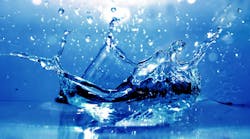By Thacher Worthen
Last year I surprised my 7 year old daughter at school as the “mystery reader”. Instead of reading The Cat in the Hat I decided to talk about what I did for a living. Mind you, these are a bunch of 7 year olds and their first grade teachers. Talking to them about the mechanics and process of wastewater treatment set me up for a challenge.
Starting out, I defined what a “precious resource” was, and how limited a supply of fresh water there was in the world. They understood what a drought was because we live in the Southeast and have had a few in the last couple years. My real challenge began next, explaining that when they flushed the toilets or ran their baths it would ultimately become part of our water supply once again.
Every time I began to lose them, I would just mention toilet or potty and I would have them right back in the mix! As I walked them through the importance of this mysterious process, they slowly began to understand that everything they flushed or washed down the sink wound up back in the streams that run through their towns and ultimately back through their faucets when they make their Kool-Aid after school. It amazed me that I could capture their attention with such a serious and mysterious topic.
That experience reminded me about how important it is for each of us (plant managers, utilities directors, consulting engineers, manufacturers, and other officials) to talk to folks about our business. We make it complicated because we live it every day, but it can be broken down so a first grader can understand it, trust me! The questions I got were innocent and inquisitive, and many came from the impressions they received from TV shows such as Dirtiest Jobs.
“Image is everything” has been used quite a bit since the 80s, for all sorts of products and people. It couldn’t be more truthful for the water and wastewater treatment industry.
Image is a grass roots thing, meaning it starts with the people in person-to-person marketing, and spreads out exponentially. Over time images catch on whether positive or negative, thus our negative image from the public today. That image started hundreds of years ago, and became accelerated during the media age with shows such as the Honeymooners and Dirtiest Jobs.
People love water! People are drawn to water, now why don’t they have an appreciation and a passion for requiring dirty water to be cleaned and conserved? Look at Country singer Brad Paisley’s music video, “Water”. It shows passion and yearning for being around and enjoying water. How can we as an industry capitalize on that “love affair with water”? Without wastewater treatment, reclamation and reuse infrastructure, that image of great watersheds and abundant water will be gone.
Coming out of that 1st grade class made me think how powerful our industry professionals can be if we take the effort in our non professional life to educate and promote the importance of what we do, and that our end product is vital to life on this planet.
Why do roads, bridges, and buildings get all the limelight and substantial infrastructure resources? Because they are visible and sexy, and people understand their importance. Our industry has a huge job to do marketing our end product, but so do we as individuals who actually live and work in the water and wastewater industry!
So what’s in it for us? 1) Image, 2) More educated population, 3) Better decision makers in the future, 4) More public pressure to make our unseen infrastructure better, 5) more infrastructure investment in water and wastewater, and 6) better water quality, and more re-use. Oh, by the way this will take years to see any effect, but get started, it’s easy and it can actually be fun to implement.
WW
About the author: Thacher Worthen is president of Schreiber LLC, a Birmingham, Alabama-based manufacturer of energy-efficient, innovative, and propriety equipment / process technology from head works to tertiary filtration. Circle No. 254 on Reader Service Card
instantly on which design they wanted us to pursue,” Fiore said.
Visualization
Once the architectural theme was chosen, AECOM participated in an extensive site application process where visualization capabilities proved increasingly valuable. During this phase, a number of public hearings and meetings were held to elicit comments and gain buy-in from both the Davie planning and zoning commission and the community at large. Residents of a private, multi-family development were particularly interested in attending these meetings as the facility was to be built across the street from their community.
To address their concerns, the team created model-based visualizations and animations and then projected them onto large screens during presentations. They also displayed 3D renderings on large boards. Ultimately, the photorealistic visualizations were instrumental in gaining public support. In fact, after experiencing the 3D presentations of the facility’s final look, the developer of the multi-family community became an outspoken supporter of the project.
“From a management perspective, 3ds Max helped us create some fantastic graphics. With them, we were able to show, in three dimensions, how the facility was progressing,” Fiore said. “It allowed the Town of Davie and the community to really envision what the facility was going to look like. That was a huge advantage.”
The software also helped AECOM provide an unanticipated yet valued service. According to Bruce Taylor, Town of Davie Utility Director, “AECOM went above and beyond its prescribed role of designing and building the plant. By visualizing the project for our citizens, it was easier for everyone to understand what the final site would look like. It helped us get the green light from our constituency much earlier than we expected.”
Collaboration
Once the initial designs had been approved, AECOM held periodic workshops with city stakeholders to keep them informed of project progress. During this phase, the project team relied on Autodesk collaboration capabilities to review, explore, and analyze 3D models with the client. With help from Navisworks Manage, AECOM presented high-quality rendered 3D images and animations of the future plant. During virtual walkthroughs, they identified potential conflicts and made fact-driven decisions to avoid future reworks, costs, and delays.
During one workshop, the team made a significant discovery and changed plans as a result. Because the new plant is a membrane facility, it requires vertical turbine feed pumps to sit alongside membrane skids. Once the plant begins operation, the pumps will need to be removed periodically for maintenance.
“During one Navisworks-based review, we clearly saw that the forklifts the Town of Davie had planned on using to remove the pumps were simply not going to work,” Fiore said. “With support from the collaboration tools, we helped them explore more options, and guided them to make better decisions regarding future maintenance based on the parameters of the area of these pumps. Ultimately, we helped them decide to evaluate a longer-term solution of overhead cranes to support maintenance of these pumps.”
Now in the construction phase of this design-build project, AECOM continues to combine their process of information-led design with Autodesk BIM technology to collaborate effectively across multiple architectural, engineering, and construction teams. The firm’s engineers face much less of a challenge communicating design intent, and now experience the power of BIM for design coordination, collaboration, clash detection, and visualization.
“In the long run, Autodesk BIM solutions help us produce more comprehensive designs,” Fiore said. “We can identify design conflicts early on and clearly communicate what the project is going to look like to the client before construction begins.”
WW
About the Author: Brian Stitt is a senior project manager with over 20 years experience and is based out of AECOM’s Sunrise, FL, offices. He has extensive experience in water and wastewater treatment and is currently project manager for the $100 million Davie water treatment and water reclamation design build project. His experience includes design and construction of both water and wastewater facilities including technologically advanced facilities that generate effluent suitable for indirect reuse.
More WaterWorld Current Issue Articles
More WaterWorld Archives Issue Articles


